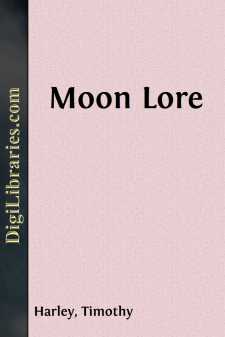Categories
- Antiques & Collectibles 13
- Architecture 36
- Art 48
- Bibles 22
- Biography & Autobiography 813
- Body, Mind & Spirit 142
- Business & Economics 28
- Children's Books 14
- Children's Fiction 11
- Computers 4
- Cooking 94
- Crafts & Hobbies 4
- Drama 346
- Education 46
- Family & Relationships 57
- Fiction 11829
- Games 19
- Gardening 17
- Health & Fitness 34
- History 1377
- House & Home 1
- Humor 147
- Juvenile Fiction 1873
- Juvenile Nonfiction 202
- Language Arts & Disciplines 88
- Law 16
- Literary Collections 686
- Literary Criticism 179
- Mathematics 13
- Medical 41
- Music 40
- Nature 179
- Non-Classifiable 1768
- Performing Arts 7
- Periodicals 1453
- Philosophy 64
- Photography 2
- Poetry 896
- Political Science 203
- Psychology 42
- Reference 154
- Religion 513
- Science 126
- Self-Help 84
- Social Science 81
- Sports & Recreation 34
- Study Aids 3
- Technology & Engineering 59
- Transportation 23
- Travel 463
- True Crime 29
Moon Lore
by: Timothy Harley
Categories:
Description:
Excerpt
MOON SPOTS.
I. INTRODUCTION.
With the invention of the telescope came an epoch in human history. To Hans Lippershey, a Dutch optician, is accorded the honour of having constructed the first astronomical telescope, which he made so early as the 2nd of October, 1608. Galileo, hearing of this new wonder, set to work, and produced and improved instrument, which he carried in triumph to Venice, where it occasioned the intensest delight. Sir David Brewster tells us that "the interest which the exhibition of the telescope excited at Venice did not soon subside: Sirturi describes it as amounting to frenzy. When he himself had succeeded in making one of these instruments, he ascended the tower of St. Mark, where he might use it without molestation. He was recognised, however, by a crowd in the street, and such was the eagerness of their curiosity, that they took possession of the wondrous tube, and detained the impatient philosopher for several hours till they had successively witnessed its effects." it was in May, 1609, that Galileo turned his telescope on the moon. "The first observations of Galileo," says Flammarion, "did not make less noise than the discovery of America; many saw in them another discovery of a new world much more interesting than America, as it was beyond the earth. It is one of the most curious episodes of history, that of the prodigious excitement which was caused by the unveiling of the world of the moon." Nor are we astonished at their astonishment when they beheld mountains which have since been found to be from 15,000 to 26,000 feet in height--highlands of the moon indeed--far higher in proportion to the moon's diameter than any elevations on the earth; when they saw the surface of the satellite scooped out into deep valleys, or spread over with vast walled plains from 130 to 140 miles across. No wonder that the followers of Aristotle resented the explosion of their preconceived beliefs; for their master had taught that the moon was perfectly spherical and smooth, and that the spots were merely reflections of our own mountains. Other ancient philosophers had said that these patches were shadows of opaque bodies floating between the sun and the moon. But to the credit of Democritus be it remembered that he propounded the opinion that the spots were diversities or inequalities upon the lunar surface; and thus anticipated by twenty centuries the disclosures of the telescope. The invention of this invaluable appliance we have regarded as marking a great modern epoch; and what is usually written on the moon is mainly a summary of results obtained through telescopic observation, aided by other apparatus, and conducted by learned men. We now purpose to go back to the ages when there were neither reflectors nor refractors in existence; and to travel beyond the bounds of ascertained fact into the regions of fiction, where abide the shades of superstition and the dreamy forms of myth. Having promised a contribution to light literature, we shall give to fancy a free rein, and levy taxes upon poets and story-tellers, wits and humorists wherever they may be of service....


